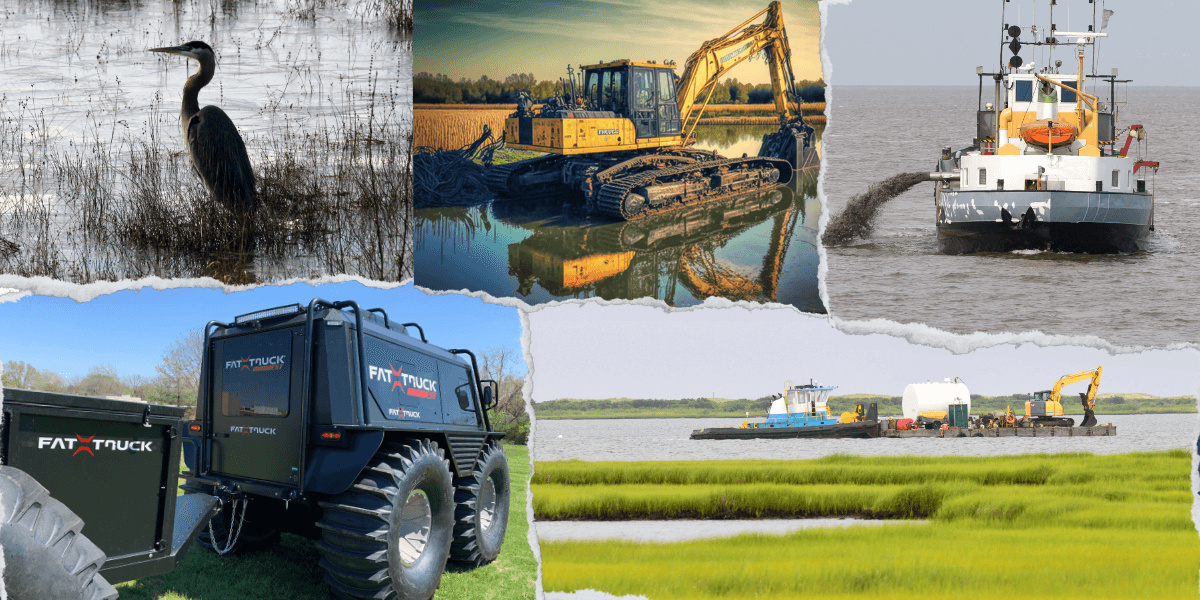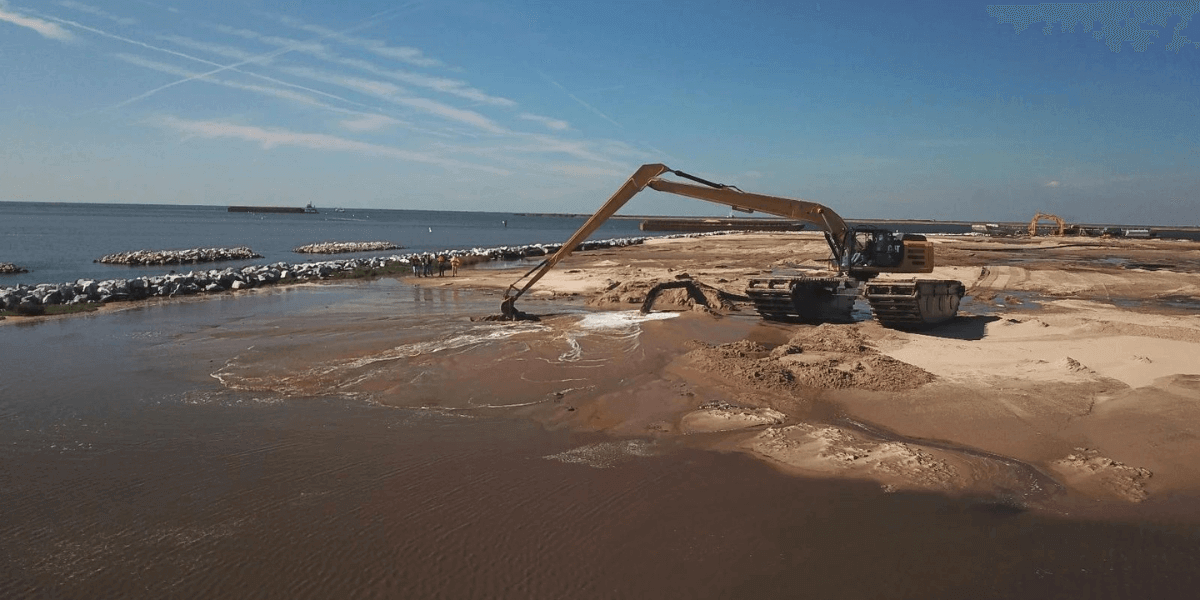Marsh buggy: What you need to know
Picture this—you’re deep in a sprawling wetland, surrounded by thick mud and waterlogged terrain. Traditional vehicles are useless here, sinking into...
5 min read
U.S. Aqua Services Feb 19, 2025 11:06:30 AM

Dredging and wetland restoration often present unique challenges, especially when dealing with unstable terrain, shifting water levels, and remote locations. Traditional construction and excavation equipment struggle in these environments, leading to inefficiencies and increased operational risks. This is where amphibious equipment stands out. Designed to navigate land and water, these specialized machines ensure that projects continue smoothly, no matter the conditions.
From marsh buggies to amphibious excavators and the highly versatile Fat Truck, these vehicles redefine how industries approach dredging services and environmental restoration. This article explores their applications, benefits, and factors when selecting the right equipment for the job.
Choosing the Right Amphibious Equipment for the Job and Factors to Consider
U.S. Aqua's Amphibious Equipment Supports Dredging Operations and Wetland Restoration
Amphibious equipment is essential for projects that require mobility across both land and water. These specialized machines ensure reliable operation in challenging environments where standard vehicles cannot perform effectively.
Amphibious equipment refers to machinery specifically designed to operate in areas where both land and water conditions exist. Unlike conventional construction vehicles, these machines are built with flotation capabilities, low ground pressure, and specialized tracks or tires that prevent them from sinking into soft ground. This makes them essential for industries that rely on dredging services, wetland conservation, and flood mitigation.
Amphibious machines stand apart because they transition seamlessly between solid and semi-submerged conditions. Their most defining features include:
Low ground pressure: Spreads the machine's weight over a large surface area, preventing it from sinking into soft mud or marshland.
Sealed undercarriages: Ensures buoyancy and prevents water damage to essential components.
Specialized propulsion systems: These include track-driven or water-jet propulsion to enhance maneuverability.
Multi-purpose adaptability: Used for dredging, transportation, environmental restoration, and pipeline maintenance.
With these features, amphibious vehicles ensure that projects remain on schedule, even in the most challenging landscapes.
Amphibious equipment comes in various forms, each designed to tackle specific challenges in wetland and dredging operations. From excavators built for underwater digging to versatile transport vehicles like the Fat Truck, these machines provide the mobility and stability needed for demanding environments.
Excavators are essential for dredging services, but standard models quickly become ineffective when dealing with marshy or flood-prone areas. Amphibious excavators are built to handle these conditions by incorporating sealed pontoons and hydraulic undercarriages. They are frequently used for:
Dredging and sediment removal in shallow water.
Shoreline restoration projects that require precision excavation.
Wetland conservation efforts to prevent erosion and habitat loss.
Their ability to work directly in waterlogged environments makes them indispensable for many restoration and construction projects.
Marsh buggies, also known as amphibious personnel carriers, are built to transport workers, tools, and materials across environments that would otherwise be inaccessible. These machines feature:
Wide tracks that prevent sinking into soft terrain.
Flotation capabilities for crossing water channels.
Flexible design that allows for modifications like cranes or drilling equipment.
They are commonly used for oil pipeline maintenance, land reclamation, and access to remote dredging sites.
The Fat Truck is a compact, all-terrain vehicle engineered for extreme mobility. Unlike larger amphibious machines, it prioritizes rapid personnel and equipment transport in difficult environments.
Key benefits of the Fat Truck include:
All-terrain capability: Moves effortlessly over mud, snow, and water.
Enclosed cabin for safety: Protects passengers from harsh environmental conditions.
High flotation tires: Prevents the vehicle from getting stuck, even in deep water.
Its role in dredging services is crucial, as it provides quick access to job sites that traditional vehicles cannot reach, ensuring that crews can perform critical tasks without delays..webp?width=1920&height=759&name=2%20(1).webp)
Amphibious equipment plays a vital role in dredging services by providing access to difficult terrain, ensuring stability in shifting environments, and enhancing safety for operators. These machines make it possible to complete projects efficiently in areas where traditional equipment would struggle or fail.
Dredging operations often occur in unpredictable environments where soft ground and fluctuating water levels create logistical nightmares. Amphibious equipment is specifically designed to overcome these obstacles. By distributing weight efficiently and utilizing sealed components, these machines ensure reliable performance without the risk of sinking or getting stranded.
Many dredging projects take place in areas where road infrastructure is nonexistent. Traditional excavation equipment requires dry, stable ground, which can be impossible to find in wetland or coastal restoration projects. Amphibious vehicles bridge this gap by providing the mobility needed to access these sites without requiring extensive land modification.
With the ability to traverse flooded areas, swamps, and marshes, these machines reduce the time and costs of transporting materials and crews.
Safety is always a priority in dredging operations. The use of amphibious equipment significantly lowers risks by:
Reducing the chance of vehicle entrapment in deep mud or unstable ground.
Providing secure transportation for workers in hazardous conditions.
Offering greater stability in fluctuating water levels.
These factors ensure that dredging projects are efficient and conducted with the highest regard for worker safety.
Selecting the right amphibious equipment depends on several key factors:
Terrain type: The level of water saturation and ground softness will determine whether an amphibious excavator, marsh buggy, or Fat Truck is needed.
Project scope: Some tasks require heavy excavation, while others prioritize personnel transport.
Mobility requirements: The need to navigate deep water versus shallow wetlands will influence equipment selection.
Understanding these factors ensures that the most effective machinery is deployed for each specific dredging operation.
Using the right equipment is only part of the equation—knowing how to use it effectively is just as important. Partnering with experienced professionals in amphibious equipment ensures that projects run smoothly from start to finish.
U.S. Aqua specializes in deploying the best equipment for dredging services, wetland restoration, and land reclamation. With a deep understanding of amphibious machinery, we provide tailored solutions that meet the unique demands of each project.
Amphibious equipment plays a crucial role in overcoming the challenges of dredging and wetland restoration. These machines enable projects to continue in areas where conventional equipment would fail by offering unmatched mobility, stability, and safety. Whether it's the power of an amphibious excavator, the adaptability of a marsh buggy, or the unmatched access provided by the Fat Truck, these vehicles are essential for navigating tough environments.
For businesses needing reliable dredging services, investing in the right amphibious equipment makes all the difference. With the expertise and tools to tackle any terrain, U.S. Aqua stands ready to help projects succeed, no matter the conditions.
U.S. Aqua Services was created to support the dredging process in advancing commerce and responding to its many challenges. To accomplish this, our dredging company assembled an exceptional group of experienced individuals and a diverse inventory of dredge equipment.
We offer dredging equipment rental services so you can have access to the latest and greatest in dredging technology without having to pay to maintain it, transport, and store it, along with dewatering services.
With an emphasis on mobility, dependability, durability, diversity, efficiency, and safety, our dredging rental company can ensure that our different types of dredging systems are easy to move through any terrain and can work in the most rugged and remote environments. Our multi-function hydraulic systems are built with jetting and mechanical options that can efficiently move loose sediment or stiff layers of clay.
US Aqua services also and maintains a ready fleet of amphibious equipment capable of completing dredging projects in some of the harshest and most remote environments. U.S Aqua is also the dealer for Louisiana of the amphibious vehicle Fat Truck. No matter the size or scope of the job or the remoteness of your work location, you can rely on Fat Truck’s industrial off-road utility vehicles to get the job done right.

Picture this—you’re deep in a sprawling wetland, surrounded by thick mud and waterlogged terrain. Traditional vehicles are useless here, sinking into...
.png)
When your worksite sits somewhere between land and water, standard construction gear simply won’t do the job. That’s where amphibious equipment comes...

Wetlands are some of the planet's most delicate and ecologically valuable environments. Whether for conservation, restoration, or infrastructure...